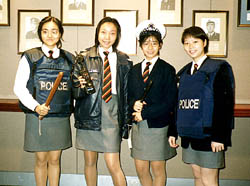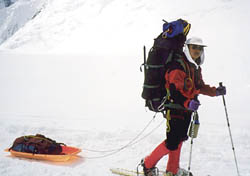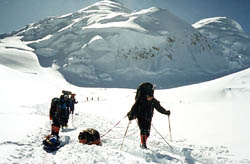



















| |
|
WINNERS of the Help the Police Fight Youth
Crime Competition'98 recently returned from their goodwill trips to Australia and Singapore
where they met with city officials, police representatives, young adults and members of the
local press to help spread the fight crime message, learn about police work in other places
and have a good time.
The Fight Youth Crime competition was organised by the Hong Kong Police Force to raise young people's fight crime awareness and to tap their ideas on how best to tackle juvenile crime and drug abuse. It was sponsored by Hang Seng Bank and Qantas Airways Limited. The 10 winners were selected from over 19,000 entrants through a series of quizzes, written essays and interviews, and awarded trips to Australia and Singapore for their winning suggestions on curbing juvenile crime. As Hong Kong's fight crime ambassadors, the first five were welcomed in Sydney by the Deputy Director of the Hong Kong Economic and Trade Office, Kevin Yeung, and Superintendent of New South Wales Police, Bob Myatt. During their stay, the young emissaries' busy schedule included a tour of the Sydney offices of the Hong Kong Economic and Trade Office, the Hong Kong Tourist Association and the Hong Kong Trade Development Council; a visit to the Sydney Police Centre, their Radio Operations Room, and Pistol Range; a meeting with the local Chinese community; a Sydney harbour cruise on a Police launch; an one-day camp with Aussie Sea Scouts; and lots of sightseeing. In Melbourne, they toured Victoria Police Headquarters with Superintendent (Community Services) Frank Byrne, and City Councillor Wellington Lee; visited the Detective Training School and the Australian Police Museum; witnessed a display of various Victorian Police formations (Air Wing, Mounted Branch, Public Awareness Caravan, Bicycle Patrol Group and Traffic Operations Group), and met Chief Commissioner Neil Comrie of the Victoria Police before paying a visit to a police station in Williamstown. |
 Young fight crime ambassadors in Oz
|
|
They also met with students from local secondary schools who accompanied them on a sightseeing tour of Sovereign Hill (an outdoor museum), and a wildlife park. Meanwhile, the second group of five young Hong Kong fight crime ambassadors travelled to Singapore to disseminate fight crime messages and to learn more about police work there. During their stay in Singapore as Hong Kong goodwill ambassadors they visited the city's Police Headquarters, its National Police Cadet Corps Headquarters, a neighbourhood police post, the National Youth Centre, the Tanah Merah Prison, Taman Bacaan Female Halfway House and Toa Payah Girl's Home. At the Police Headquarters, they were briefed on the juvenile crime situation and had dinner with the Deputy Director of the Public Affairs Department Chin Fook Leong and his officers. The ambassadors also met the local media. | |
The rugged terrain and bitterly cold temperatures of Mount McKinley (elevation 20,000 feet) is an extreme challenge to even the most seasoned climbers, as Detective Police Constable Lok Wai-keung of the Organised Crime and Triad Bureau who scaled the Alaskan mountain with 11 fellow climbers last May found out . . . | |
 Detective Police Constable Lok Wai-keung on the Mt. McKinley expedition 
|
FORTY-TWO-year-old mountain climber
Detective Police Constable Lok Wai-keung has explored mountain ranges from China, to
the Americas (both North and South), to Nepal. His biggest challenge to date, however, was
Mt. McKinley-the highest mountain in North America.
Lok and other members of the Himalayas Mountaineering Club, including renowned local climber Cham Yik-kai, started preparing for the Mt. McKinley ascent more than a year in advance to ensure that the climb went as smoothly as possible ? which it didn'tt. But then the "man against nature" element of mountain climbing has always been a major part of its appeal. Along with a tough physical training regimen (which included hauling around rucksacks packed with back-breaking weights), team members familiarised themselves with nutrition and emergency first-aid especially for altitude sickness and frostbite. They also gathered as much information as they could about the undertaking-especially data on past McKinley expeditions. |
|
Specialised equipment assembled for the climb included sub-zero weather sleeping bags as well as insulated gear such as clothing and boots which preserve body warmth in temperatures as low as minus 30 degrees Celsius. "Twelve of us set off in small groups on 29 May amid unstable weather conditions which saw temperatures fluctuating between minus 10 and minus 20 degrees with frequent blizzards and poor visibility," recalled DPC Lok, who helps organise mountaineering events for the Police Adventure Club. Connected to each other with ropes, the expedition members made their way slowly up jagged rock faces and across gigantic glaciers negotiating hazardous crevasses, rock slides and extremely bad weather conditions. On some days the temperatures reached 38 degrees Celsius with strong, blinding sunshine, then at a moment's notice dropped to minus 25 degrees. Freezing blizzards were frequent, as were the more dangerous white-outs which enveloped the climbers in wind-blown snow and ice pellets reducing visibility to nil. En route through the mountain's infamous "Windy Corner" (where wind speeds soared to 100 miles per hour), Lok and his team members were forced to take shelter in a make-shift camp that was literally blown apart by the fierce gusts. The climbers then dug themselves into caves in the snow. Exhausted and running out of food, two members of Lok's three-member climb unit fell victim to frostbite and altitude sickness and had to make their way back leaving him to carry on his adventure alone. Of the 12 members of the expedition, seven made it to Mt. McKinley's summit-although Detective Police Constable Lok was not one of them. With the peak in sight, the exhausted and solitary climber, despite suffering minor frostbite on his hands and feet, had a hard time deciding to call it quits. "I really wanted to continue the journey but in the end conceded that safety was my priority. So during a break in the storm, I made my way back to the base camp," said Lok, who shed 15 pounds during the gruelling 18-day experience. Lok Wai-keung and his climbing colleagues have set their next goal on an 8,000-metre mountain ridge of the Tibetan Himalayas in the year 2000. | |

![]()
